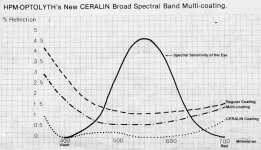Out of curiosity, seeing some pop up on second hand every now and then, does anyone have some good info (years of production, evaluation, specs…) about the evolution of coatings on Optolyth scopes, like their draw tube scopes?
Older scopes have either the more general German term « breitband Vergütung », mainly on scopes labelled « Made in Germany, or « Ceralin » mentioned as coatings (some specific coating name from Optolyth, like Swarovski would say « SwaroXyz » now, or « Iralin » in the past?) often on scopes labelled « Made in West Germany ». Recently/currently, « Ceralin Plus » seems to be used.
‘Ceralin‘ and ‘Breitband Vergütung’ both appear on scopes with (seemingly) identical specs (e.g. some 22x70), probably mainly due to one being the evolution of the other, I assume. «Made in West Germany » obviously already suggests some manufacturing period, at least for the ’Ceralin’ ones, but still:
I have seen Gijs van Ginkel’s measurements on some Optolyth draw tube scopes, but I am not sure about the manufacturing period and used/labelled coatings on those measured scopes.
They don’t seem to be in the same league as recent Swarovski draw tube scopes or many other more ’standard’ field scopes from good brands (not only the « alpha »), but considering their much lower second hand price, maybe they are still interesting low-priced options, also as robust options (e.g. in comparison to small 50mm scopes which are also often less expensive and used at 20-30x).
Older scopes have either the more general German term « breitband Vergütung », mainly on scopes labelled « Made in Germany, or « Ceralin » mentioned as coatings (some specific coating name from Optolyth, like Swarovski would say « SwaroXyz » now, or « Iralin » in the past?) often on scopes labelled « Made in West Germany ». Recently/currently, « Ceralin Plus » seems to be used.
‘Ceralin‘ and ‘Breitband Vergütung’ both appear on scopes with (seemingly) identical specs (e.g. some 22x70), probably mainly due to one being the evolution of the other, I assume. «Made in West Germany » obviously already suggests some manufacturing period, at least for the ’Ceralin’ ones, but still:
- Does anyone know for sure the order or periods of those coatings/products?
- Or if they differ significantly regarding brightness and/or colour accuracy etc.?
- Did they evolve or improve over the years, even before changing names, like Swarovski-coatings do?
I have seen Gijs van Ginkel’s measurements on some Optolyth draw tube scopes, but I am not sure about the manufacturing period and used/labelled coatings on those measured scopes.
They don’t seem to be in the same league as recent Swarovski draw tube scopes or many other more ’standard’ field scopes from good brands (not only the « alpha »), but considering their much lower second hand price, maybe they are still interesting low-priced options, also as robust options (e.g. in comparison to small 50mm scopes which are also often less expensive and used at 20-30x).







